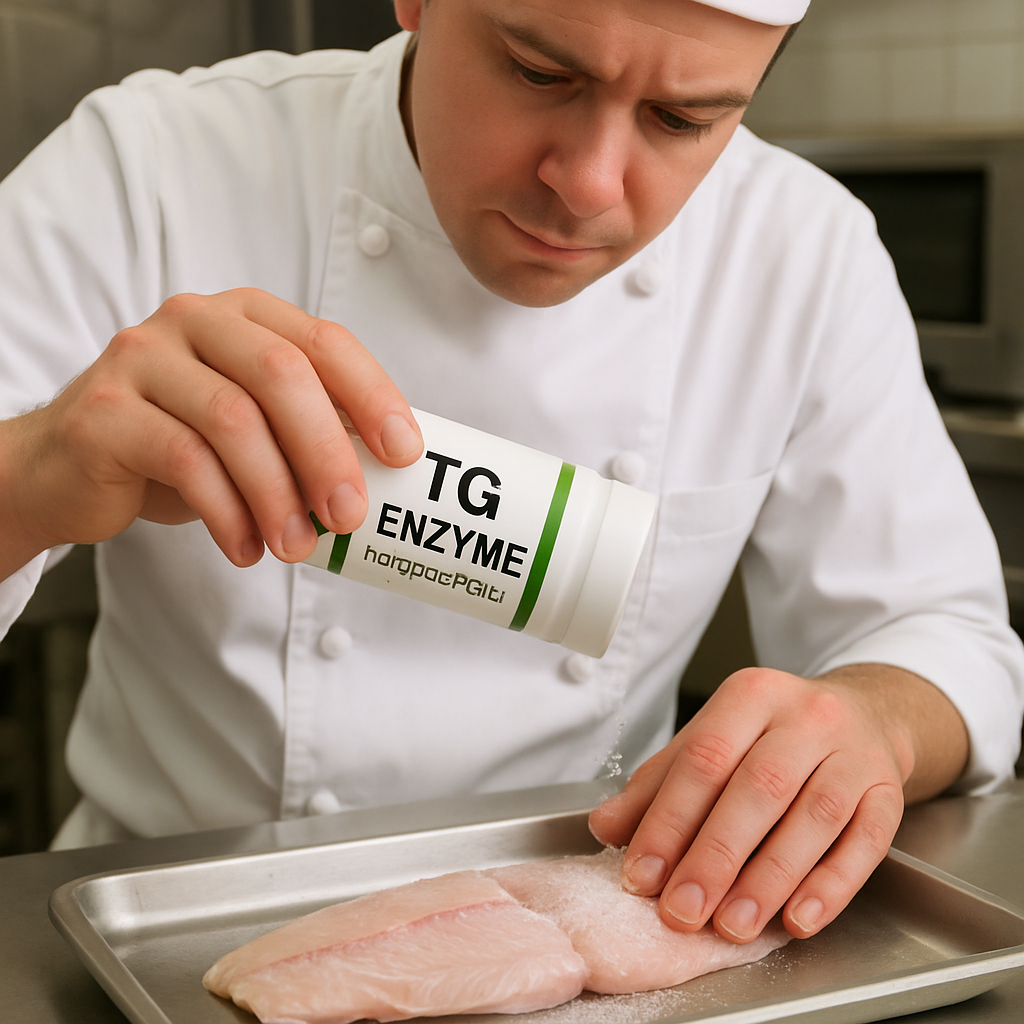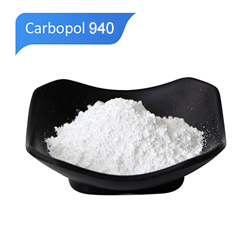Transglutaminase (TG Enzyme): Redefining Fish Texture in Culinary Innovation
When it comes to culinary innovation, the TG enzyme, also known as transglutaminase, is making significant waves in the food industry. This protein cross-linking enzyme is transforming the texture of fish and other proteins, leading to exciting possibilities for chefs and food manufacturers alike. But what exactly is the TG enzyme, and how does it redefine fish texture? Let's dive into the science behind this molecular architect and explore its applications in the culinary world.

Microscopic view of transglutaminase enzyme
Transglutaminase is an enzyme that catalyzes the formation of covalent bonds between proteins, effectively "gluing" them together. It occurs naturally in various organisms, including animals, plants, and bacteria. In the food industry, transglutaminase is commonly used to improve the texture, appearance, and nutritional value of food products.
Nature's Molecular Glue
Transglutaminase acts as a biological adhesive, enhancing the structural integrity of proteins. This enzyme is not exclusive to the food industry; it plays a vital role in biological processes such as blood clotting and skin formation. Its ability to form stable covalent bonds between proteins makes it indispensable in both nature and culinary applications. By understanding its natural function, we can appreciate its transformative impact on food textures.
The Science of Protein Cross-Linking
The magic of transglutaminase lies in its ability to link glutamine and lysine residues within proteins. This cross-linking process creates a mesh-like structure, enhancing the structural resilience of the proteins. In culinary terms, this means that foods can maintain their shape and texture under various cooking conditions. The cross-linking not only provides firmness but also retains moisture, which is crucial for maintaining the quality of fish and other delicate proteins.
From Nature to Kitchen
Transglutaminase is harvested and refined for culinary use, bridging the gap between natural processes and food innovation. The enzyme is sourced from various origins, including microbial fermentation, which ensures its availability for industrial applications. By harnessing this enzyme, chefs and manufacturers can elevate food textures beyond their natural limitations, creating products that are both visually appealing and texturally satisfying.
The Use of TG Enzyme in Fish Processing
The use of transglutaminase in fish processing has gained popularity due to its ability to modify and improve texture. Here are some ways TG enzyme is utilized in redefining fish texture:
Improving Fish Fillet Cohesion
Fish fillets, especially those from flaky fish like cod or haddock, can easily fall apart during cooking. Applying transglutaminase helps bind the fish proteins together, resulting in a firmer fillet that withstands various cooking methods, including grilling and frying, without disintegrating.
Transglutaminase acts as a binding agent, fortifying fish fillets against the stresses of cooking. This is particularly beneficial for flaky fish varieties, which traditionally struggle to hold together during preparation. The enzyme's action ensures that the fillets maintain their structure, providing a consistent and satisfying texture from the kitchen to the dining table. This cohesion also enhances the moisture retention of the fillets, leading to a juicier and more flavorful eating experience.
Creating Uniform Fish Products
In the food industry, consistency is key. Transglutaminase allows manufacturers to produce uniform fish products, such as fish sticks or patties, by binding smaller pieces of fish into a single, cohesive product. This not only enhances texture but also ensures even cooking and a more appealing presentation.
Uniformity in food products is essential for both consumer satisfaction and manufacturing efficiency. Transglutaminase enables the creation of cohesive fish products from smaller, disparate pieces, ensuring that each bite offers the same quality and texture. This uniformity is crucial for processed fish products like fish sticks, where consistency in cooking and flavor is paramount. The enzyme facilitates the bonding process, allowing for the creation of standardized products that meet consumer expectations and reduce food waste.
Reducing Fish Waste
The TG enzyme also plays a role in reducing fish waste. By enabling the binding of fish trimmings or offcuts, manufacturers can create new products from what would otherwise be discarded. This not only maximizes resource efficiency but also contributes to more sustainable food production practices.
In the pursuit of sustainability, reducing food waste is a critical goal. Transglutaminase assists in this endeavor by allowing manufacturers to utilize fish trimmings and offcuts that would typically be discarded. By transforming these remnants into cohesive products, the enzyme helps minimize waste and promotes a more sustainable approach to food production. This not only conserves valuable resources but also supports the food industry's efforts to operate more sustainably and responsibly.
Culinary Creativity with TG Enzyme

Gourmet dish featuring fish with enhanced texture by mk. s (https://unsplash.com/@mk__s)
Beyond industrial applications, transglutaminase opens up a realm of creativity for chefs looking to experiment with textures and presentations. Here are some innovative culinary uses of the TG enzyme:
Novel Fish Dishes
Chefs can use transglutaminase to create unique fish dishes that push the boundaries of traditional cuisine. By cross-linking proteins, chefs can craft new textures and shapes, offering diners a fresh take on familiar ingredients.
Transglutaminase empowers chefs to experiment with textures, allowing them to break free from conventional culinary constraints. By manipulating protein structures, chefs can design novel dishes that surprise and delight diners. This creative freedom enables the development of dishes that are not only innovative in texture but also in flavor and presentation, offering patrons an experience that challenges and expands their culinary expectations.
Enhancing Nutritional Profiles
The TG enzyme can also be used to enhance the nutritional profile of fish dishes. By binding protein-rich ingredients, chefs can create meals that are not only delicious but also packed with essential nutrients.
Nutritional enhancement is a significant advantage of using transglutaminase in culinary applications. By binding various protein-rich components, chefs can craft dishes that deliver enhanced nutritional benefits without sacrificing taste or texture. This capability allows for the creation of meals that are both healthful and indulgent, meeting the growing consumer demand for nutritious yet satisfying dining options.
Artistic Presentation
For those interested in the visual appeal of food, transglutaminase allows for the creation of intricate, visually stunning dishes. The enzyme's ability to bind proteins provides chefs with the flexibility to sculpt and mold fish into captivating presentations that delight the eyes and the palate.
Food presentation is an art form, and transglutaminase offers chefs a unique tool to elevate their artistic endeavors. The enzyme's binding properties enable the crafting of elaborate and visually striking dishes that capture the imagination. By sculpting proteins into creative shapes and forms, chefs can produce plates that are not only delicious but also visually captivating, enhancing the overall dining experience.
Safety and Consumer Perception
While the TG enzyme offers numerous benefits, it's important to address safety and consumer perception. Transglutaminase is generally recognized as safe (GRAS) by food safety authorities, and its use in food products is subject to stringent regulatory standards.
Addressing Consumer Concerns
Some consumers may have concerns about the use of enzymes like transglutaminase in food. Transparent labeling and education about the safety and benefits of the TG enzyme can help alleviate these concerns. By understanding the science and purpose behind its use, consumers can make informed choices about the foods they consume.
Consumer education is crucial in addressing concerns surrounding transglutaminase use. By providing transparent information about the enzyme's safety and benefits, food manufacturers can build consumer trust and acceptance. Educating consumers on the scientific basis and regulatory oversight of transglutaminase helps demystify its use, empowering them to make informed dietary choices and fostering a positive perception of enzyme-enhanced products.
Ensuring Quality Control
To maintain consumer trust, food manufacturers must adhere to high standards of quality control when using transglutaminase. Ensuring the correct application and dosage of the enzyme is crucial to achieving desired results while maintaining the safety and integrity of the final product.
Quality control is paramount in the successful application of transglutaminase in food products. Manufacturers must rigorously monitor the enzyme's use, ensuring proper dosages and application techniques are employed. This attention to detail is essential to guarantee that the final products meet safety standards and deliver the expected quality, thus maintaining consumer confidence and trust in enzyme-enhanced foods.
Regulatory Standards and Safety
Transglutaminase's safety is supported by its recognition as GRAS by food safety authorities. The regulatory oversight ensures that its use in food production adheres to stringent safety and quality standards. This regulatory framework provides assurance to both manufacturers and consumers, reinforcing the enzyme's role as a safe and beneficial tool in the food industry.
The Future of TG Enzyme in Fish Processing
As the food industry continues to evolve, the role of the TG enzyme in fish processing is likely to expand. With ongoing research and development, we can expect to see new and innovative applications that further enhance the culinary landscape.
Sustainable Practices
The use of transglutaminase aligns with the growing demand for sustainable food production. By reducing waste and maximizing the use of raw materials, the TG enzyme contributes to more environmentally friendly practices in the food industry.
Sustainability is increasingly becoming a priority in the food industry, and transglutaminase offers a pathway to more sustainable practices. By minimizing waste and optimizing resource use, the enzyme supports environmental goals while enhancing product quality. Its role in promoting sustainability reflects the industry's commitment to reducing its ecological footprint and advancing responsible production methods.
Expanding Horizons
Beyond fish, transglutaminase has the potential to transform the texture and quality of other protein-based foods, including meat and plant-based alternatives. As chefs and manufacturers explore new possibilities, the TG enzyme will continue to be a valuable tool in the quest for culinary innovation.
The versatility of transglutaminase extends beyond fish, offering transformative potential for a wide range of protein-based foods. Its application in meat and plant-based alternatives opens new possibilities for texture enhancement and product development. As the food industry embraces plant-based diets and alternative proteins, transglutaminase will play a crucial role in shaping the future of food, driving innovation and expanding culinary horizons.
Advancements in Research and Development
Ongoing research into the applications and benefits of transglutaminase is likely to yield exciting advancements in the food industry. As scientists and culinary professionals continue to explore the enzyme's potential, new techniques and uses will emerge, further solidifying its place as a cornerstone of modern food technology.
In conclusion, the TG enzyme is a remarkable molecular architect that is redefining fish texture and opening up new possibilities in the culinary world. From improving texture and
 Food Grade Sodium Hyaluronate
Food Grade Sodium Hyaluronate Cross-linked Sodium Hyaluronate
Cross-linked Sodium Hyaluronate Cosmetic Grade Sodium Hyaluronate
Cosmetic Grade Sodium Hyaluronate D-panthenol
D-panthenol γ-Polyglutamic Acid
γ-Polyglutamic Acid Allantoin
Allantoin Alpha Arbutin
Alpha Arbutin Beta Arbutin
Beta Arbutin Kojic Acid
Kojic Acid Kojic Acid Dipalmitate
Kojic Acid Dipalmitate 3-o Ethyl Ascorbic Acid
3-o Ethyl Ascorbic Acid Ascorbyl Glucoside
Ascorbyl Glucoside β-Nicotinamide Mononucleotide(NMN)
β-Nicotinamide Mononucleotide(NMN) β-Nicotinamide Mononucleotide(NMN)
β-Nicotinamide Mononucleotide(NMN) Nicotinamide Adenine Dinucleotide(NAD+)
Nicotinamide Adenine Dinucleotide(NAD+) Glutathione
Glutathione Coenzyme Q10
Coenzyme Q10 Pyrroloquinoline Quinone(PQQ)
Pyrroloquinoline Quinone(PQQ) Chondroitin Sulfate
Chondroitin Sulfate Methyl Sulfonyl Methane
Methyl Sulfonyl Methane Glucosamine Hydrochloride
Glucosamine Hydrochloride Glucosamine Sulfate Potassium Chloride
Glucosamine Sulfate Potassium Chloride N-Acetyl-D-Glucosamine
N-Acetyl-D-Glucosamine Vitamin K2
Vitamin K2

















































